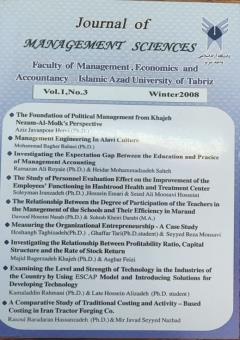Investigating the Relationship Between Profitability Ratio, Capital Structure and the Rate of Stock Return
Subject Areas : Business Managementmajid bagherzadeh khajeh 1 * , Asghar Feyzi 2
1 - Department of Management, Tabriz Branch, Islamic Azad University, Tabriz, Iran
2 - Master of Business Administration (Financial Orientation) from Aras-Tabriz Higher Education Institution
Keywords: Rate of Stock Return, Profitability Ratio, Rate of Capital Structure,
Abstract :
The main purpose of this study has been to investigate if there is a significant relationship between the profitability ratio, capital structure, and the rate of stock return. To do this, first, a definition of the rate of stock return, profitability ratio, and ratio of the company’s capital structure has been provided and then a t-test, f-test and correlation computations have been calculated. The related data have been collected from the concrete companies which have been active in Tehran stock exchange for thee years. The population of this study includes all of the concrete companies which have been accepted in Tehran stock exchange during the mentioned period. After selecting the related companies, we calculated the ratio by conducting a linear and non-linear regression. The results indicate that there is not a significant relationship between the ratio of profitability, capital structure, and the rate of stock return in concrete companies accepted in Tehran stock exchange during the years 1382- 1384.
Hampton, V. (1996). Financial Management. Translated by: H. R., Vakili Fard, Tehran: Samareh Publication, (In Persian).
Leim, D. B. (2003). Financial market Anomalies. Journal of financial Economices.
Langemeier, M. R. (2000). Financial Ratios Used in Financial Management. Kansas State University.
Leopold, A., & Bernstein, J. W. (1999). Analysis of Financial Statements. McGraw-Hill Professional.
Lipe, R. C. (1996). The Information Contained in the Components of Earning. Journal of Accounting Research, 24.
Masah, M. (2005).Technical Analysis (from A to Z). Tehran: Chalesh Publication, (In Persian).
Montgomery, D. C. (1992). Introduction to Linear Regression Analysis.
Niederhoffer, V., & Patrick, K. J. R. (1972). Earning Changes Analyst Forecasts and Stock Price. financial Analysts Journal, 3.
Nuno, R. P. (2001). Financial Management. First volume. Translated by Ali Jahankhani and Ali Parsaeian. Tehran: Samt Publication, (In Persian).
Peter, D. E., & Trevor, S. H. (1991). Earning as an Explanatory Variable for Return. Journal of Accounting Research.
Raei, R., & Talangori, A. (2004). Advanced Investment Management. First Edition. Tehran: Samt Publication, (In Persian).
Scott, B., & Eugene, F. B. (1999). Principles of Finance. The Dryden Press.
_||_Hampton, V. (1996). Financial Management. Translated by: H. R., Vakili Fard, Tehran: Samareh Publication, (In Persian).
Leim, D. B. (2003). Financial market Anomalies. Journal of financial Economices.
Langemeier, M. R. (2000). Financial Ratios Used in Financial Management. Kansas State University.
Leopold, A., & Bernstein, J. W. (1999). Analysis of Financial Statements. McGraw-Hill Professional.
Lipe, R. C. (1996). The Information Contained in the Components of Earning. Journal of Accounting Research, 24.
Masah, M. (2005).Technical Analysis (from A to Z). Tehran: Chalesh Publication, (In Persian).
Montgomery, D. C. (1992). Introduction to Linear Regression Analysis.
Niederhoffer, V., & Patrick, K. J. R. (1972). Earning Changes Analyst Forecasts and Stock Price. financial Analysts Journal, 3.
Nuno, R. P. (2001). Financial Management. First volume. Translated by Ali Jahankhani and Ali Parsaeian. Tehran: Samt Publication, (In Persian).
Peter, D. E., & Trevor, S. H. (1991). Earning as an Explanatory Variable for Return. Journal of Accounting Research.
Raei, R., & Talangori, A. (2004). Advanced Investment Management. First Edition. Tehran: Samt Publication, (In Persian).
Scott, B., & Eugene, F. B. (1999). Principles of Finance. The Dryden Press.

